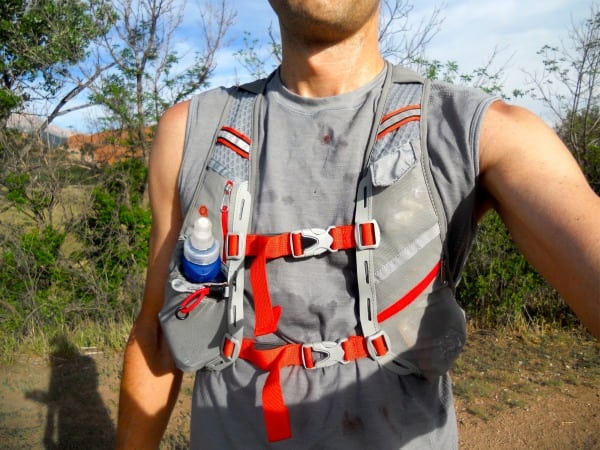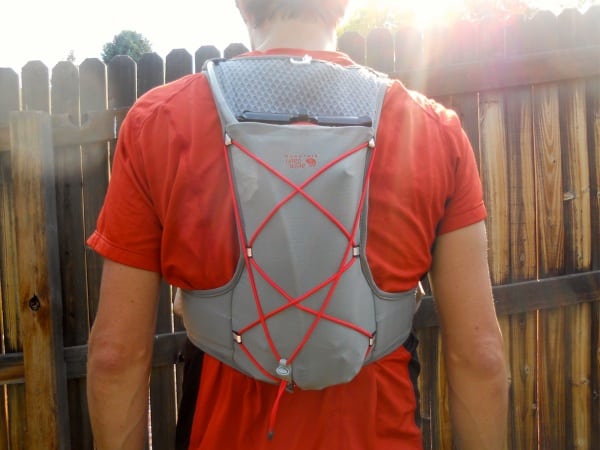Are you a bottle or a pack person? Check out any trail race and you’re bound to see runners neatly divided into these two categories, and as hydration packs become more lightweight and innovative, bottle users can no longer use the excuse that packs are bulky and hindersome. The dawn of the race vest has brought lightweight, barely noticeable, pack options with a variety of storage mechanisms. Seen with increasing regularity on the trails is the, gasp, pack and bottle combo! While other hydration packs have received more press and big marketing pushes, the Mountain Hardwear Fluid Race Vest ($60) has snuck mostly under the radar. Not to be confused with the more recently released Fluid Race Pack which has additional storage, the Fluid Race Vest is a lightweight, no frills, affordable pack, which at first glance is even underwhelming.
Over the past five months I’ve had the opportunity to take this pack on outings between two and seven hours, always managing to cram more than enough unnecessary gear into its surprisingly expansive compartments.

The front of the Mountain Hardwear Fluid Race Vest.
Shape, Construction, Fit
The Fluid Race Vest comes in two sizes small/ medium and medium/ large. The S/M size is meant to fit runners with chest-width measurements between 16-19 inches and the M/L size 18.5-22 inches (measuring straight across the chest). I received the S/M size for testing, and with an 18-inch torso my first impression was that this vest felt a little snug. I was underestimating the elasticity of the straps on the front of the vest as well as its ability to hug and conform to the torso. The fit of the Race Vest feels higher on the ribs than other hydration vests I’d worn and it took some getting used to. The function of this fit became immediately apparent while out on the trail as I experienced absolutely zero bounce with the vest fully loaded. More on that later.
Two very simple nylon cross straps equipped with elastic bands help dial in the fit of the Fluid Race Vest. Placement of these straps is adjustable on both sides, which with a bit of playing around, could net an even more dialed in fit. I feel that the stock positioning of these straps works great for me and I didn’t need too much adjusting.
Almost ninety percent of the Fluid Race Vest is made up of very lightweight breathable mesh which has now become the industry standard for most vests. However, Mountain Hardwear kept weight down by using an even thinner stretch mesh to create pockets, and this may be the stretchiest mesh I’ve seen. What first seems like very little cargo capacity becomes exponentially larger when stretched a bit, and the mesh never seems to lose elasticity even after a machine wash.
Cargo Storage
The back compartment of the vest features an external bungee that I’ve used to hold a lightweight shell, gloves, and a hat. This main compartment is simple and can hold a surprisingly large amount of gear. In inclement weather I’ve stashed a rain shell, headlamp, gloves, hat, and extra food in this back pouch without experiencing discomfort, and although there is no back padding, I’ve even carried an extra 20-ounce water bottle without any discomfort. This large compartment can also be used to carry a bladder, and guide straps are present on the front of the vest to keep the drinking hose from bouncing all over. While I’ve used larger bladders in this pack, it seems to perform best with a 1.5-liter/50-ounce bladder that produced the best overall comfort-to-carrying capacity ratio.
The front right side of the Fluid Race Vest has a large bungeed pocket down low that can be used to carry a bottle, even a 20-ounce bottle, or a variety of other gear. Because the pocket angles down, carrying a bottle does take a little getting used to, but I found myself leaning more and more to putting a soft flask in this compartment which seemed to take up less room and it also alleviated the annoying sloshing sound of carrying a bottle. Above this compartment is a small zippered pocket which can be used to carry pills, a few gels, or other small items (a credit card does not fit into this pocket).
The front left side of the vest features a large zippered compartment on the bottom that accommodated a smartphone or numerous gels. (I think I crammed eight in there once!) The pocket above this is a smaller with a velcro flap which also works well to store electrolytes, keys, and small items. No pockets on the vest are waterproof, which was my only disappointment on this vest.

Mountain Hardwear Fluid Race Vest from behind.
Overall Performance
With a price tag of $60 and an unloaded weight of 5.6 ounces, the Fluid Race Vest is the lightest and cheapest major-manufacturer race vest on the market. Given these stats I expected absolute minimalism, yet what I found was an incredibly versatile way to store the essentials which feels like part of my body while I’m running. When loaded with only gels, pills, and clothing, I experienced absolutely no bouncing, and with a 50-ounce bladder bouncing was very minimal. Most of the time I’ve worn the Fluid Race Vest, which is almost every long run in the past four months, I’ve forgotten that I had it on.
If you’re like me and running belts feel uncomfortable to store your food or gear, a minimal pack like the Race Vest is the way to go. With a myriad of options for carrying a bladder, storing a bottle, or using soft flasks you can customize this vest to meet the needs of almost any distance.
[Note: The Mountain Hardwear Fluid Race Vest is normally available in the iRunFar Store.]
